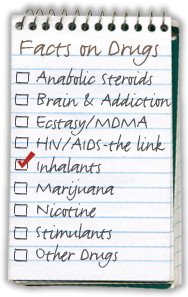Inhalants
What Are the Common Effects?

Most of us don't think of spray paint, glue, household cleaners, and the like as drugs because we're used to seeing such products under the kitchen sink, in the bathroom, or on the grocery shelves. Inhalants are easy to get, and children and adolescents are among those most likely to abuse these potentially toxic substances.
Initial Effects
The lungs rapidly absorb inhaled chemicals into the bloodstream, quickly distributing them throughout the brain and body. Within minutes of inhalation, users feel "high." The effects are similar to those produced by alcohol and may include slurred speech, lack of coordination, euphoria, and dizziness. Inhalant users may also experience lightheadedness, hallucinations, and delusions. [2] The high usually lasts only a few minutes.
With repeated inhalations, many users feel less inhibited and less in control. Some may feel drowsy for several hours and experience a lingering headache. [2]
Effects on the Brain
Inhalants often contain more than one chemical. Some chemicals leave the body quickly, but others can remain for a long time, absorbed by fatty tissues in the brain and central nervous system. [4]
One of these fatty tissues is myelin, a protective cover that surrounds many of the body's nerve fibers (neurons). Myelin helps nerve fibers carry their messages to and from the brain. Damage to myelin can slow down communication between nerve fibers. [2]
Long-term inhalant use can break down myelin. When this happens, nerve cells are not able to transmit messages as efficiently, which can result in muscle spasms and tremors or even permanent difficulty with basic actions like walking, bending, and talking. [3] These effects are similar to what happens to patients with multiple sclerosis—a disease that also affects myelin.
Inhalants also can damage brain cells by preventing them from receiving enough oxygen. [4] The effects of this condition, also known as brain hypoxia, will depend on the region affected. The hippocampus, for example, helps control memory, so someone who repeatedly uses inhalants may lose the ability to learn new things or may have a hard time carrying on simple conversations. [4] If the cerebral cortex is affected, the ability to solve complex problems and plan ahead will be compromised. And, if the cerebellum is affected, it can cause a person to move slowly or clumsily. [4]
Inhalants can be addictive. Long-term use can lead to compulsive drug seeking and use, and mild withdrawal symptoms.
Other Health Effects
Regular abuse of inhalants can cause serious harm to vital organs besides the brain, including the heart, kidneys, and liver. [2] Inhalants can cause heart damage, liver failure, and muscle weakness. [5] Certain inhalants can also cause the body to produce fewer blood cells, which may result in a condition known as aplastic anemia (in which the bone marrow is unable to produce blood cells). [5] Frequent long-term use of certain inhalants can cause a permanent change or malfunction of peripheral nerves, called polyneuropathy. [5]
Specific Effects by Type of Inhalant
Depending on the type of inhalant abused, the adverse health effects will differ. The table below lists a few examples.
Examples of Effects by Type of Inhalant [1]
| Inhalant | Examples | Effects |
|---|---|---|
| Toluene |
|
|
| Trichloroethylene |
|
|
| Hexane |
|
|
| Nitrous Oxide |
|
|
| Benzene |
|
|
Butane (found in cigarette lighters and refills) makes the heart extra sensitive to a chemical that carries messages from the central nervous system to the heart. This chemical, noradrenaline, tells the heart to beat faster when someone is in a stressful situation. [4] If the heart becomes too sensitive to noradrenaline, it can affect the heart's rhythm, with potentially lethal consequences. [4]
Nitrite abuse has other health risks. Unlike most other inhalants, which act directly on the central nervous system, nitrites enlarge blood vessels, allowing more blood to flow through them. Inhaled nitrites make the heart beat faster and produce a sensation of heat and excitement that can last for several minutes. Nitrites can also cause dizziness and headaches. Nitrites are more often used by older adolescents and adults (primarily to enhance sexual pleasure and performance), and their abuse is associated with unsafe sexual practices that can increase the risk of contracting and spreading infectious diseases, such as HIV and hepatitis. [2]
Lethal Effects
Prolonged sniffing of the highly concentrated chemicals in solvents or aerosol sprays can induce irregular or rapid heart rhythms and can lead to heart failure and death within minutes of a session of prolonged sniffing. [2] This "sudden sniffing death" is particularly associated with the abuse of butane, propane, and chemicals in aerosols. [2]
High concentrations of inhalants also can cause death from suffocation by displacing oxygen in the lungs and then in the central nervous system so that breathing ceases. Deliberately inhaling from a paper or plastic bag or in a closed area, for example, greatly increases the chances of suffocation.
While high on inhalants, users also can die by choking on their own vomit or by fatal injury from accidents, including car crashes. [2]
If Inhalants Are Harmful, Why Do Kids Use Them?
Many kids think inhalants are a harmless, cheap, and quick way to "catch a buzz." Because many inhalants can be found around the house, kids may not even think they are harmful. But the chemicals in the inhalant vapors can change the way the brain works and cause other complications in the body. What kids often don't know is that, in some cases, the harmful effects of inhalants can be irreversible.
Are Inhalants Addictive?
Some individuals, particularly those who abuse inhalants heavily and for a long time, report a strong need to continue using inhalants. Compulsive use and a mild withdrawal syndrome can occur. Additionally, recent research in animal models has shown that toluene can affect the brain in a similar manner as other drugs of abuse (i.e., amphetamines). Toluene increases dopamine activity in reward areas of the brain, and the long-term disruption of the dopamine system is one of the key factors leading to addiction.
How Can I Tell if Someone Is Abusing Inhalants?
A person who is using inhalants might have chemical odors on their breath or clothing; paint or other stains on their face, hands, or clothing; nausea or loss of appetite; weight loss; muscle weakness; disorientation; or inattentiveness, uncoordinated movement, irritability, and depression.
What Should I Do if I Know Someone Is Using Inhalants?
When someone has a drug problem, it's not always easy to know what to do. If someone you know is using inhalants, encourage him or her to talk to a parent, school guidance counselor, or other trusted adult. If the person prefers, there are also resources that are anonymous — for example, the National Suicide Prevention Lifeline at 1-800-273-TALK. They don't just talk about suicide; they can help with a lot of issues, including drug abuse, and can connect this person with a professional close by. In addition, the Substance Abuse and Mental Health Services Administration's Center for Substance Abuse Treatment (CSAT) offers a National Drug and Alcohol Treatment Service that provides free and confidential information on hotlines and counseling services. CSAT's toll-free phone number is 1-800-662-4357; treatment centers by state can also be located at www.findtreatment.samhsa.gov.
References
| 1. |
National Institute on Drug Abuse. NIDA InfoFacts: Inhalants (http://www.nida.nih.gov/Infofax/inhalants.html). Bethesda, MD: NIDA, NIH, DHHS. Revised April 2006. Retrieved March 2007. |
| 2. |
National Institute on Drug Abuse. NIDA Research Report: Inhalant Abuse (http://www.drugabuse.gov/researchreports/inhalants/inhalants.html). NIH Publication No. 00-3818. Bethesda, MD: NIDA, NIH, DHHS. Printed 1994. Reprinted 1996, 1999. Revised March 2005. Retrieved March 2007. |
| 3. |
University of Michigan, Institute for Social Research. 2005 Monitoring the Future Study (funded by NIDA). Data tables. (www.monitoringthefuture.org). Retrieved March 2007. |
| 4. |
National Institute on Drug Abuse. Mind Over Matter: Inhalants (http://teens.drugabuse.gov/mom/mom_inha1.php). NIH Pub. No. 03-4038. Bethesda, MD: NIDA, NIH, DHHS. Printed 1997. Reprinted 1998, 2000, 2003. Retrieved March 2007. |
| 5. |
National Institute on Drug Abuse. Mind Over Matter: Teaching Guide. Inhalants (http://teens.drugabuse.gov/mom/tg_inha1.php). NIH Publication No. 00-3592. Bethesda, MD: NIDA, NIH, DHHS. Printed 1997, 1998. Revised 2000. Retrieved March 2007. |
Search.
Enter your keywords and click the button to submit the search.Need Treatment
Glossary
Exercise your brain
Free Downloads
Answer This
Mind Over Matter


